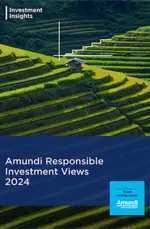Summary
1. Big Green" Tailwinds
From the US Inflation Reduction Act to the EU Green deal industrial plan, trends to watch for responsible investors.
-
Policy packages in the US, the EU and in China will spur massive flows of investment towards the development of green technology innovations, which are destined to have a long-lasting impact on tech and their energy sources worldwide.
-
The US Inflation Reduction Act (IRA) is a major breakthrough in the race of green technology investments, expected to unlock around $400 billion in incentives and tax credits over the next decade for American manufacturers and push the green tech race to a new level.
-
In response to the IRA, the EU launched the Green Deal Industrial Plan. The plan builds upon previous policy packages such as Fit for 55 or REPowerEU, which aims to mobilise close to €300 billion by 2030 to support clean energy investments.
-
5 green tech trends to watch in 2024: sodium batteries, artificial intelligence for smart emissions management, green steel, carbon capture and storage, and alternative marine fuels.
2. Staying the course on climate with a net zero compass
-
The first Global Stocktake (GST) revealed that global CO2 emission levels have exceeded interim targets to meet the 2050 objective of the Paris Agreement. To achieve the global objective of net zero, annual global clean energy spending has to rise from $1.8 trillion in 2023 to $4.5 trillion by 2030 (source: IEA), and governments must issue and follow through on more ambitious climate-related policies.
-
Climate strategy has become an essential component of long-term investors’ risk management toolbox. Responsible investors should favour an integrated net zero framework that embraces both alignment and contribution dimensions.
-
Tail risks stemming from both physical risks and transition risks should not be underestimated by investors.
3. Sustainable capital mobilisation in EMDEs: the coming of age of blended finance?
- Climate-related investments in emerging markets and developing economies (EMDEs) will need to increase to $2 trillion per year by 2030 (source: IEA). GSS+ bond issuance in EMDEs should continue to grow as the energy transition accelerates and investor demand rises.
- Despite solid GSS+ market momentum, only a small portion of climate finance is being redirected towards adaptation. Scaling up climate adaptation and transition financing is particularly important for EMDEs as they are the most affected by climate change. The success of the transition at a global scale depends on the success of the transition in emerging markets.
- To quickly ramp up clean energy investment in EMDEs, public capital has a significant role to play, but it will not be sufficient on its own. Private capital needs to be leveraged and crowded in. Blended finance appears an ideal solution for leveraging public capital to de-risk private investments and channel massive flows of private money.
- To address critical questions on how to stimulate private climate investment in EMDEs, several reforms to Multilateral Development Banks (MDBs) and Development Finance Institutions (DFIs) have been proposed in recent years.
4. In need of a general equilibrium theory of sustainable and inclusive growth?
- “Planetary boundaries”, a concept to delineate the environmental limits within which humanity can safely operate, provides a compelling framework for analysing interconnected risks across the different dimensions that regulate Earth’s systems.
- Assessing issuers’ exposure to planetary boundaries through a double materiality risk assessment enables the integration of biodiversity, climate and other nature dimensions into a single overarching framework.
- Biodiversity is essential for the wellbeing of our societies and a healthy economic system. It is estimated that $44 trillion of economic value generation (source: World Economic Forum) is dependent on biodiversity. Despite growing attention to biodiversity and nature, action from companies and investors has so far remained limited due to data collection and reporting challenges, but we expect further mobilisation going forward.
- For the transition to be successful in the long term, it needs to be socially acceptable. Integrating just transition considerations with planetary boundaries adds another layer of complexity, but enables responsible investors to shed light on critical trade-offs and avoid overly simplistic transition narratives. Beyond the buzzword, just transition frameworks help anchor sustainable aspirations in the real world.
5. EU sustainable finance action plan.
We have achieved more transparency, will we see more capital flowing in to support sustainable and inclusive growth?
- The EU Sustainable Finance Action Plan (the Action Plan) has brought transformative changes to the European sustainable funds landscape, with increased transparency and upgraded standards.
- The evolution of the Action Plan is set to have a profound, long-lasting impact on sustainable funds, shaping what can be defined as “sustainable investing 3.0”. Its impact is global: regulators around the world regard it as a benchmark for their own sustainable finance legislations and its extraterritorial reach should not be underestimated.
- At the same time, to achieve its objective of financing the transition through individual choices, the Action Plan should 1) provide clarity in the range of sustainable finance offering, to ensure they are comparable across asset management companies and understandable by end investors, and 2) tailor sustainable finance offering to the needs of end investors, to ensure savings are mobilised massively to finance the transition and not restricted to a niche sector.
6. What are the implications of the ESG and greenwashing backlash in the US and in Europe?
- After several years of broadly consensual expansion, responsible investing is facing a backlash in multiple regions around the world: for some, the approach is too timid and should go beyond financial materiality considerations to embrace outcome and impact, while others believe it has gone too far and is breaching fiduciary duties.
- The ESG backlash should rather be seen as a sign that the industry is maturing. While it is important to keep up with emerging laws, attitudes and politics, and continually assess the impact of these developments, it has become even more critical for the industry to bring clarity to the value propositions at product level and to the commitment(s) made at corporate level.
- Despite the hype of this debate, a growing number of investors (67%) are convinced of the materiality of ESG factors (source: Morningstar). While political debate and backlash may continue in the coming election year, ESG factors materiality is here to stay, and investors – responsible or otherwise – should hold the course.

Get the full picture of our Responsible Investment views for 2024
With special thanks for the support to:
Jean-Jacques Barbéris, Head of Institutional and Corporate Clients Division & ESG
Vincent Mortier, Group Chief Investment Officer
Monica Defend, Head of Amundi Institute
With the contributions of:
Isabelle Charles
Sylvia Chen
Carine Chouchana
Jordi Debrulle
Florent Deixonne
Edouard Dubois
Joan Elbaz
Julien Foll
Grace Guan
Patrick Haustant
Yasunori Iwanaga
Mathieu Jouanneau
Tegwen Le Berthe
Theo Le Guenedal
Caroline Le Meaux
Sara Lovisolo
Aaron Mcdougall
Molly Minton
Yannic Raulin
Angge Roncal Bazan
Thierry Roncalli
Sofia Santarsiero
Alexis Sciau
Takaya Sekine
Andreas Steinert
Craig Sterling
Luda Svystunova
Theophile Tixier
Kristy Wong








